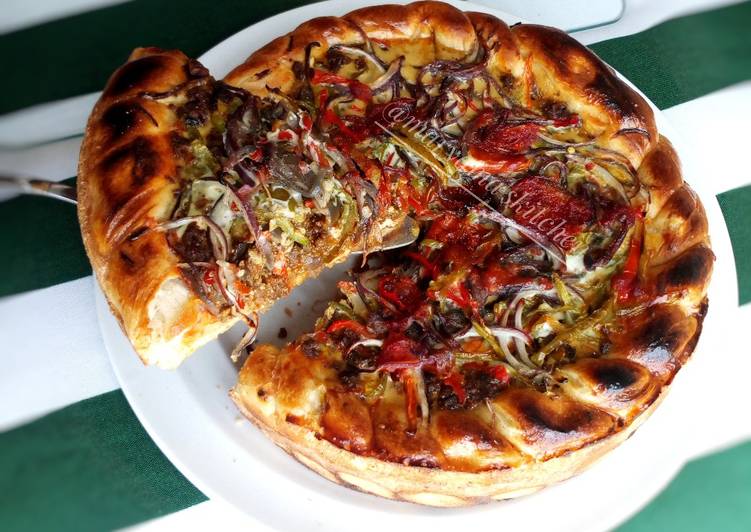
Hello everybody, hope you are having an amazing day today. Today, we’re going to prepare a special dish, thick ankake sauce for crispy noodles and rice bowls. One of my favorites. This time, I’m gonna make it a bit tasty. This is gonna smell and look delicious.
Thick Ankake Sauce for Crispy Noodles and Rice Bowls is one of the most well liked of recent trending meals on earth. It is easy, it’s fast, it tastes yummy. It’s enjoyed by millions daily. Thick Ankake Sauce for Crispy Noodles and Rice Bowls is something that I’ve loved my whole life. They’re nice and they look wonderful.
UFO Kuro Kosho Niku Ankake Yakisoba. Ankake yakisoba is one of popular yakisoba style, but it's rare in cup noodles because it's difficult to recreate Ankake. The yakisoba is peppery and savory.
To get started with this recipe, we must first prepare a few ingredients. You can have thick ankake sauce for crispy noodles and rice bowls using 12 ingredients and 20 steps. Here is how you cook it.
The ingredients needed to make Thick Ankake Sauce for Crispy Noodles and Rice Bowls:
- Get Pork, shrimp, squid, frozen seafood mix, etc. (Whatever you have on hand, or just use veggies)
- Take Chinese cabbage, cabbage, carrot, onion, Chinese chives, etc. - whatever you have in your fridge
- Prepare A. Water
- Get heaping teaspoon A. Weipa
- Get to 2 teaspoons A. Soy sauce
- Take A. Sake
- Prepare A. Oyster sauce
- Take A. Mirin
- Make ready just 1 dash bit A. Grated garlic
- Take B. Salt and pepper
- Prepare to 2 tablespoons Katakuriko
- Get Sesame oil
We are making Gomoku Ankake Yakisoba, a type of noodle dish with a thick savory sauce. Even if the weather is hot, I sometimes have a craving for this dish. If the steamed noodles are not available, boil fresh noodles to al dente. Alternatively, you can place the ingredients on steamed rice and enjoy.
Steps to make Thick Ankake Sauce for Crispy Noodles and Rice Bowls:
- Cut up the meat and/or seafood into bite sized pieces, sprinkle with about 2 tablespoons of sake and leave for a while (while you're doing Steps 2 to 6).
- Cut up the vegetables so that they'll cook through fast. I used 4 leaves of Chinese cabbage, 1/4 a large onion and 2 handfuls of bean sprouts.
- Put all the A. ingredients into a pan and heat. Taste and season with salt and pepper. Heat until just before it comes to a boil. The sauce should taste just a bit too salty at this stage, and it will be just right later when you add the other ingredients.
- I use Weipa soup stock base, but if you don't have this, use another chicken soup stock base and make 250 ml of soup from it.
- Dissolve the katakuriko in 4 to 5 tablespoons of the Step 4 soup.
- If you're serving this over rice, put the rice in a serving bowl and skip ahead to Step 11.
- If you're making crispy fried noodles… Ppen up one side of a bag of semi-cooked yakisoba noodles, and microwave for 40 to 50 seconds at 600W.
- Heat up a generous amount of oil (not listed) in a frying pan over high heat. (I use vegetable oil).
- Put the heated noodles in the hot oil, and lightly untangle with chopsticks after a few seconds. Make a flat circle of noodle like a pancake.
- Press down on the noodles occasionally and keep frying until they're as browned as you want them to be. Flip over and brown the other side. Drain and put on a plate.
- Put some sesame oil in a frying pan or wok over high heat. Add the Step 1 ingredients, season with salt and pepper and stir fry.
- When the Step 11 ingredients are about 80% cooked, add the Step 2 vegetables, starting with the ones that take longer to cook. Season with salt and pepper and stir fry, taking care not to let it burn, until the vegetables are wilted.
- Add the Step 3 sauce all at once. 30 seconds after it comes to a boil, add the Step 5 katakuriko dissolved in soup and mix with your ladle so that the sauce doesn't clump.
- When the sauce has thickened, pour the contents of the pan on top of the rice or noodles and it's done. (The quail egg in the photo was this color from the start.)
- I love the thick, creamy sauce mixed with rather hard, crispy fried noodles.
- Ankake sauce always gets more watery as you eat it, right? So I like to make it rather thick to start with, whether it's over rice or on noodles.
- My family prefers a lot of rice and a lot of vegetables, so this recipe is for just 1 serving. Please make it with your preferred amount of vegetables and sauce.
- You can even enjoy pre-fried noodles with a thick ankake sauce. Or try a slightly loose ankake sauce with the burnt bits of rice on the bottom of the pot when you cook rice… try experimenting with it yourself.
- "Easy and Faultless* Restaurant Style Tenshin-don" The thick sauce on that is similar to this. - - https://cookpad.com/us/recipes/153833-restaurant-style-thick-and-creamy-tenshin-don-%E2%99%AA
- "Our Family's Golden Ratio for Delicious and Authentic Chilled Chinese Noodles" - - https://cookpad.com/us/recipes/149052-our-golden-ratio-delicious-authentic-chilled-chinese-style-noodles
How to make Korean pancake batter. Commercially available pancake mix (buchim garu, 부침가루) is a pantry staple in Korean homes. The mix is seasoned and typically includes wheat flour and other ingredients such as corn starch. Korean-style spicy pancakes made of kimchi in an egg and flour batter, served with a snappy Stir together the kimchi, kimchi juice, flour, eggs, and green onion in a bowl. Whisk together the rice vinegar, soy sauce, sesame oil, chili pepper flakes, and toasted.
So that’s going to wrap it up with this special food thick ankake sauce for crispy noodles and rice bowls recipe. Thank you very much for reading. I’m confident that you can make this at home. There’s gonna be more interesting food in home recipes coming up. Remember to save this page on your browser, and share it to your loved ones, colleague and friends. Thank you for reading. Go on get cooking!

